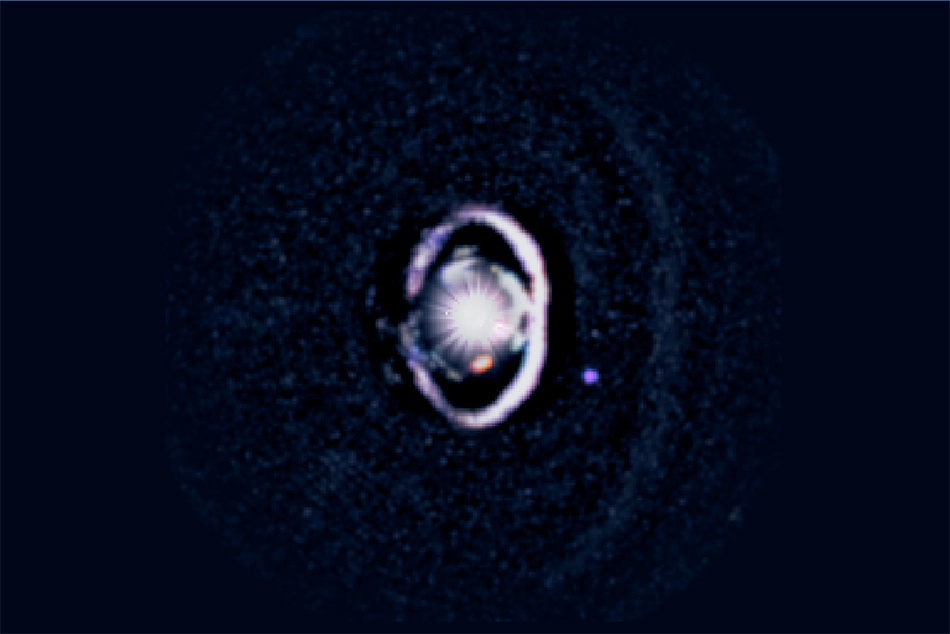
'WISPIT 2b': Researchers Discover New Baby Planet
A team of researchers have discovered a young protoplanet called WISPIT 2b embedded in a ring-shaped gap in a disk encircling a young star

[This image of the WISPIT 2 system was captured by the Magellan Telescope in Chile and the Large Binocular Telescope in Arizona. The protoplanet WISPIT 2b is a small purple dot to the right of a bright white ring of dust surrounding the system's star. A fainter white ring outside of WISPIT 2b can be seen. (Laird Close, University of Arizona)]
A team of researchers have discovered a young protoplanet called WISPIT 2b embedded in a ring-shaped gap in a disk encircling a young star.
A protoplanet is a large object in space, about the size of a moon, which forms in the protoplanetary disk around a young star from the gravitational aggregation of gas and dust.
The new baby planet WISPIT-2b was discovered by a team led by University of Arizona astronomer Laird Close and Richelle van Capelleveen, an astronomy graduate student at Leiden Observatory in the Netherlands.
This research was partially supported by a grant from the NASA eXoplanet Research Program.
Citing the research detailed in the paper "Wide Separation Planets in Time (WISPIT): Discovery of a Gap Hα Protoplanet WISPIT 2b with MagAO-X," published on August 26, 2025 in the Astrophysical Journal Letters, NASA said in addition to discovering WISPIT 2b, this team spotted a second dot in one of the other dark ring gaps even closer to the star WISPIT 2.
“This second dot has been identified as another candidate planet that will likely be investigated in future studies of the system”, the report said.
The MagAO-X instrument has the ability to capture direct images, so it didn't just detect WISPIT 2b, it essentially captured a photograph of the protoplanet.
Research Details
The star WISPIT 2 was first observed using VLT-SPHERE (Very Large Telescope - Spectro-Polarimetric High-contrast Exoplanet REsearch), a ground-based telescope in northern Chile operated by the European Southern Observatory. In these observations, the rings and gap around this star were first seen.
Following these observations of the system, researchers looked at WISPIT 2, and spotted the planet WISPIT 2b for the first time, using the University of Arizona's MagAO-X extreme adaptive optics system, a high-contrast exoplanet imager at the Magellan 2 (Clay) Telescope at Las Campanas Observatory in Chile.
The team used this technology to study the WISPIT 2 system in what is called H-alpha, or Hydrogen-alpha, light. This is a type of visible light that is emitted when hydrogen gas falls from a protoplanetary disk onto young, growing planets. This could look like a ring of super heated plasma circling the planet. This plasma emits the H-alpha light that MagAO-X is specially designed to detect (even if it is a very faint signal compared to the bright star nearby).
When looking at the system in H-alpha light, the team spotted a clear dot in one of the dark ring gaps in the disk around WISPIT 2.
More about WISPIT 2b
Being a giant and still-growing baby planet, WISPIT 2b is interesting to study on its own, but its location in this protoplanetary disk gap is even more fascinating.
“Protoplanetary disks are made of gas and dust that surround young stars and function as the birthplace for new planets”, the research paper said.
Within these disks, gaps or clearings in the dust and gas can form, appearing as empty rings. Scientists have long suggested that these growing planets are likely responsible for clearing the material in these gaps, pushing and scattering dusty disk material outwards and greeting the ring gaps in the first place.
“Our own solar system was once just a protoplanetary disk, and it's possible that Jupiter and Saturn may have cleared ring gaps like this in that disk many, many years ago”, the paper said.
“Another interesting aspect of this discovery is that WISPIT 2b appears to have formed where it was found, it didn't form elsewhere and move into the gap somehow”, the researchers found.
Follow ummid.com WhatsApp Channel for all the latest updates.
Select Language to Translate in Urdu, Hindi, Marathi or Arabic






